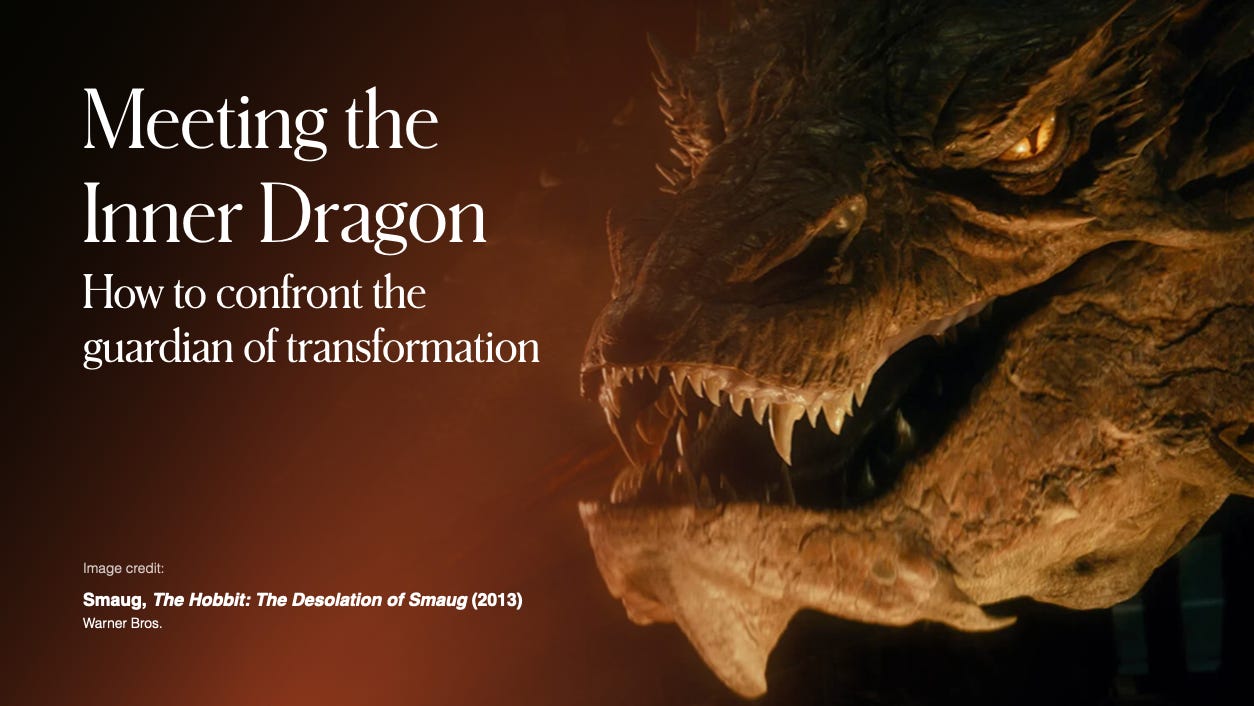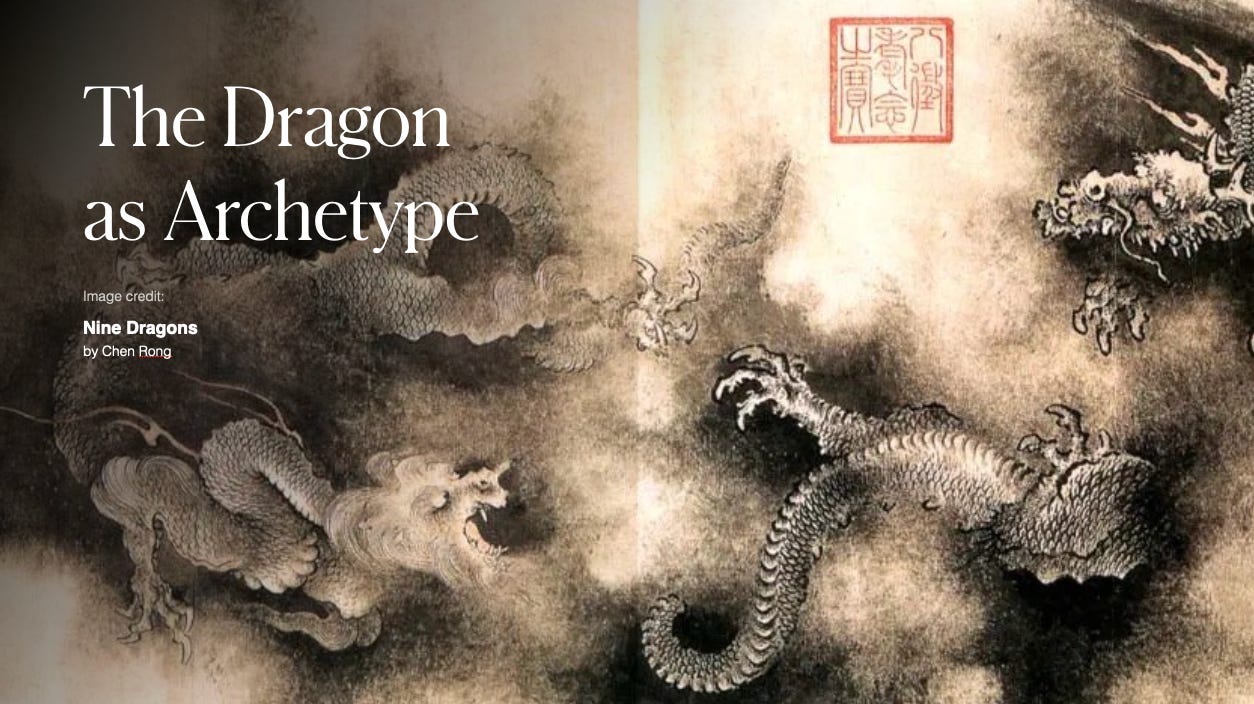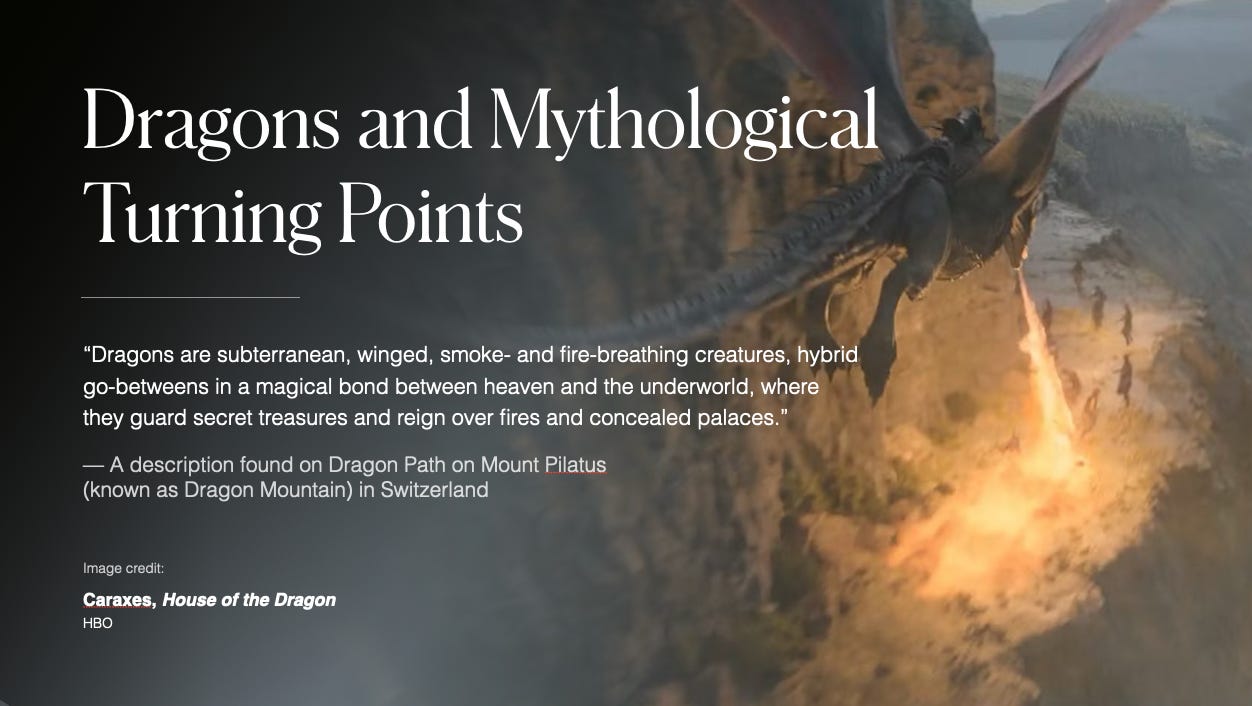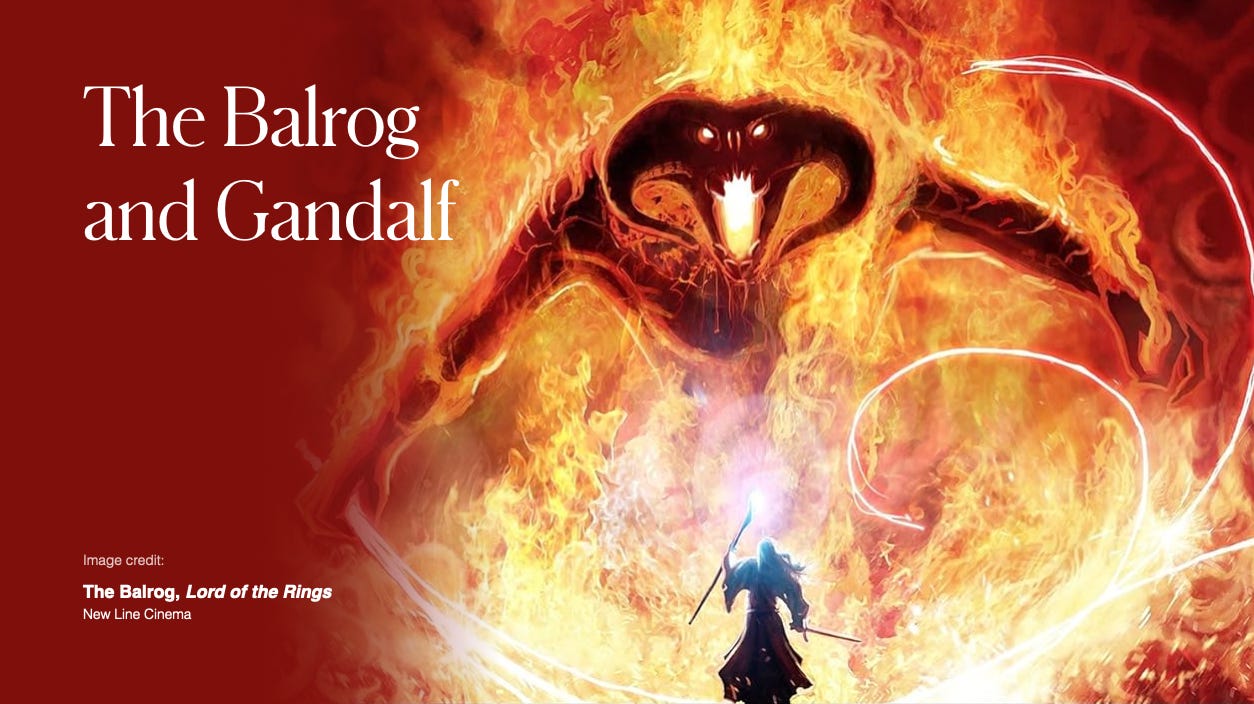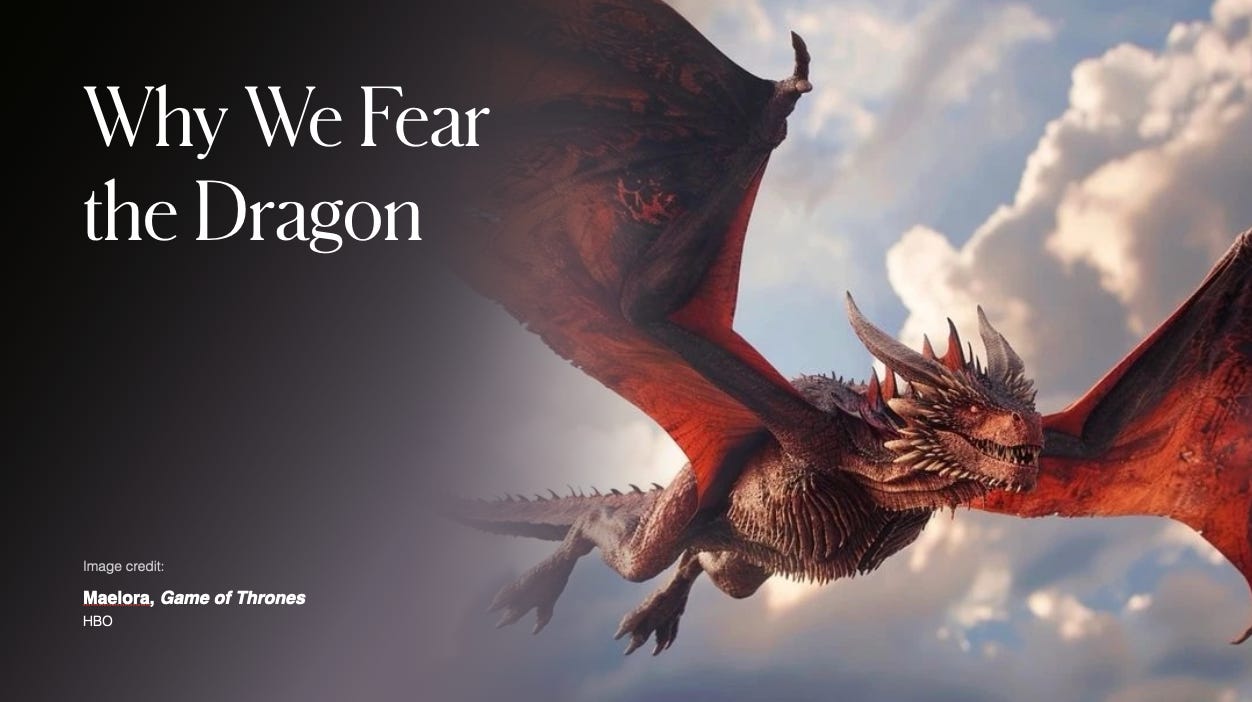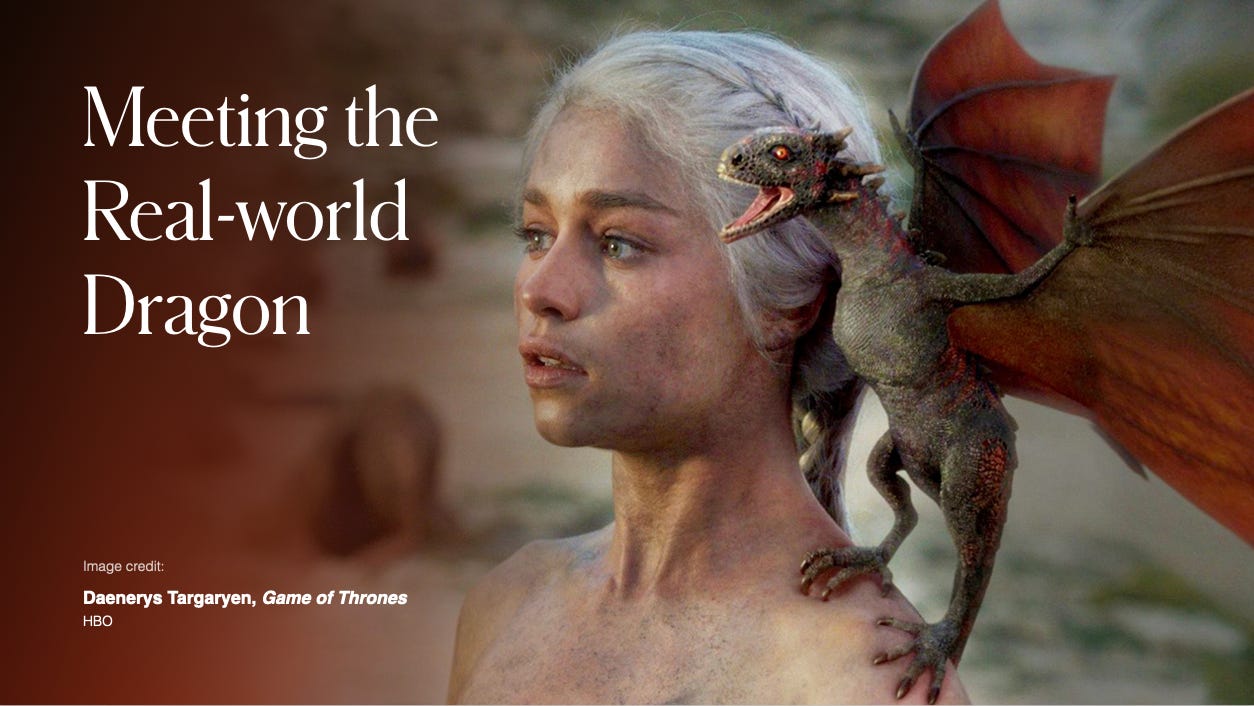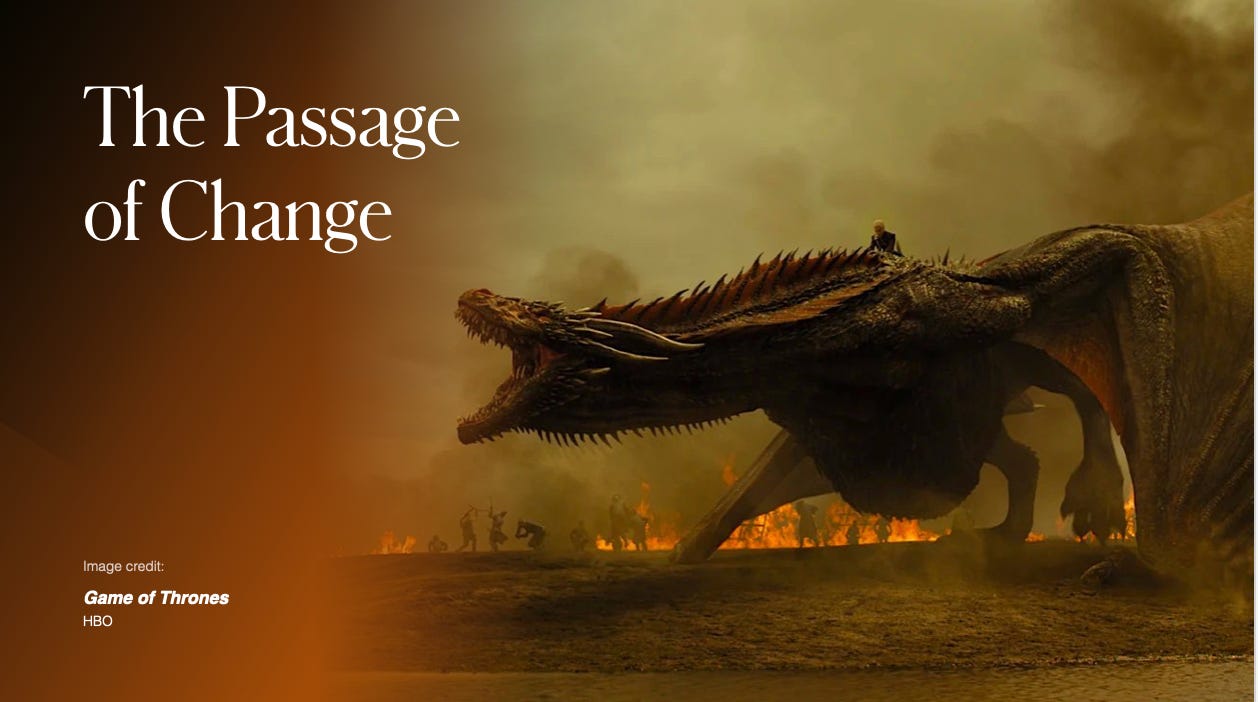Meet the Inner Dragon Confronting the guardian of transformation (Menaces of the Mind #6)
The Dragon at the gate: fear, change and the treasure you’re afraid to claim
You can listen to this post on YouTube.
***
There’s a dragon at the gate. Its scales glisten in the dark. Its breath is fire. Its roar shakes the ground beneath you. As Tolkien wrote of the dragon Smaug:
“His rage passes description - the sort of rage that is only seen when rich folk that have more than they can enjoy suddenly lose something that they have long had but have never before used or wanted.”
The Dragon does not speak, it only watches – daring you to approach.
The question here is not Will you fight this monster? but Will you walk through its fire in order to become who you were meant to be?
This piece is for anyone who’s ever stood at the edge of something life-changing and felt terrified – of who they might become, and of who they might have to stop being.
The Dragon Archetype
In almost every myth, dragons are guardians: they hoard treasure, they block passage to sacred lands, they sleep atop gold, guarding it from heroes who dare to approach.
Viewed symbolically, the dragon represents fear itself, particularly the fear of transformation – of becoming something greater than we are right now. Something different. They are the threat inherent in any transition.
Mythologist Joseph Campbell is quoted ad nauseam on this idea: “The cave you fear to enter holds the treasure you seek.” It’s a Dragon that waits at the entrance.
“Dragons are subterranean, winged, smoke- and fire-breathing creatures, hybrid go-betweens in a magical bond between heaven and the underworld, where they guard secret treasures and reign over fires and concealed palaces.”
- A description found on Dragon Path on Mount Pilatus (known as Dragon Mountain) in Switzerland
In myth, dragons mark turning points. In Norse mythology, Fafnir mutates into a cold-hearted dragon to guard his cursed gold. In Greek mythology, Ladon coils around the golden apples of the Hesperides – the fruits of immortality. In Christian mythology, St. George slays the dragon to save the city of Silene from its poisonous wrath, after which a spring flows from the site of the beast’s death, yielding water that cures all disease.
In The Lord of the Rings, the Balrog drags Gandalf the Grey down into the fires beneath the bridge of Khazad-dûm so that he can be reborn as Gandalf the White.
In each case, the dragon appears at the border between the known and the unknown, conscious and unconscious, mortal and transcendent. And it foretells great change.
Fear, alchemy and the psychology of change
Jung compared the Dragon to Mercurius – who “stands at the beginning and end of the work” of alchemy:
“He is the prima materia, the caput corvi, the nigredo; as dragon he devours himself and as dragon he dies, to rise again as the lapis. … He is metallic yet liquid, matter yet spirit, cold yet fiery, poison and yet healing draught—a symbol uniting all opposites.”
- C.G.Jung, Psychology and Alchemy, CW vol. 12, par. 404
And, indeed, the Dragon is at home in all four elements – in the sky, the water, on the earth and with the fire it breathes. In alchemical symbolism, fire represents transformation – the burning away of impurities to reveal true gold.
Facing your Dragon, then, is not about external battle, but internal alchemy: burning away illusions about who you are; releasing attachments to comfort, approval, or outdated identities; allowing a false self to die, so that the true self can be born.
Big stuff. The biggest, really. The Dragon is everywhere and everything, and our fear of it is present in every change. You cannot step into your next self without meeting it.
Why we fear the dragon
It’s easy to romanticise transformation until we’re in the midst of it. Real change always comes with a cost, and if a positive change has not made itself, then that means the price is higher than feels comfortable: the end of a relationship; the loss of an identity we once clung to; a confrontation with grief, anger, or truth long suppressed.
At the gates of change, then, the Dragon demands payment, not in gold, but in letting go of who we thought we needed to be to survive. Death, that’s the price. Like Mercurius, we must devour ourselves in order to rise again. It’s the ultimate test.
Meeting the Real-world Dragon
So what do we do when we meet the Dragon in real life?
In real life, the Dragon is fear. This means we can’t slay it like old St. George. Believe me, I’ve tried – you can’t fight fear and win. But you can listen to it.
When the Dragon breathes its fiery message, it’s testing us, challenging us to weigh up what actually, truly matters. And it’s showing us where and how change can be made.
As living beings, we are wired for safety, and since novelty and difference by definition involve the unknown, we will automatically feel afraid of the prospect of change, no matter how beneficial that change may prove to be.
So, when the Dragon appears, it draws our attention to the possibility of change as if laying down the gauntlet: “Does this matter enough?”, “Is this where you transform?”,and most importantly, “Are you brave enough to want what you want, even if it changes everything?”
Becoming
Perhaps the most terrifying thing about the Dragon’s message is that it is an unquestionable yet unsoftened and unadorned permission from within. The Dragon won’t mollycoddle, it won’t trick you into change, and it’s not here to guide you through it either; it’s here to say “This is the threshold, if you’re brave enough to cross.”
But as dispassionate as that may sound, the Dragon is of course on our side, yes? Of all the monsters we’re discussing in this series, in story, the Dragon is the one that’s most likely to become an ally. When it does, its strength and wisdom become assets rather than threats. See: How to Train Your Dragon, Merlin, Shrek, Game of Thrones, Fourth Wing.
This begs an important question: we tend to think of fear as a barrier, but what changes when we choose to see it as a form of love instead? What if the Dragon stands between you and your treasure with the express intention of ensuring you are strong enough to hold whatever waits on the other side?
For some, the Dragon is a diagnosis, a divorce, a move, a big and scary goal… it’ll look different to everyone, but its fire is always the same: it burns away the skin of who you thought you were so that you can step into your next self.
The treasure/passage/renewal
Here’s a little thought experiment for you to try on for size. I’d like you to imagine that you’re standing at the entrance to a deep, dark cave. Within, you can glimpse the faint glitter of gold or diamonds – treasure that you can’t discern just yet, but you know is there all the same.
As you squint into the shadows, something moves in the corner of your vision – an uncoiling, slow and serpentine. The Dragon’s huge head lifts into the light, black scales glimmering incandescent, flame flickering from its nostrils, and fixes you with an ancient, all-seeing gaze.
Now, you needn’t know – perhaps cannot know – which threshold it is that you have reached. You needn’t know what the treasure is on the other side, either. These things can only be known in retrospect. Right now, you have one choice to make: do you enter, or do you retreat?
If you choose to move forward – if you choose this, because you never have to – I’d like you to imagine taking step after step into the cave, the Dragon watching as you go. Perhaps your throat is dry. Maybe your stomach tightens. The closer you get, the louder your pulse, but still, the only way forward is through the heat. As you pass through the Dragon’s flames, you get the sense that a layer of self is being burned away. You don’t feel physical pain, just a bone-deep knowing that something is being shed. Something you were once too afraid to let go of, but that had to go in order for you to move on. To change. To transform into something new.
Then, darkness.
Your eyes strain to adjust. The cave feels cool, the damp air soothing against your skin. You can’t see the treasure just yet, can’t touch it either, but you will.
First, though, I’d like you to turn back towards the opening to see the Dragon coiling into itself once again, its job done. And then I’d like you to just wonder what it was that had to be burned away.
Do you have a sense of it? An idea of what you had to let go of – a belief, a tie or attachment, a fear, a plan, a promise, a perceived limitation, a pattern or thought or behaviour? A version of self? What was it that the Dragon stripped away?
If you know the answer, then you also know that the only real question the Dragon poses is this: Will you let it burn to ash? Or, perhaps, even more simply: When?
References & Citations
Carl Jung, ‘The Archetypes and the Collective Unconscious’
Carl Jung, ‘Psychology and Alchemy’
Joseph Campbell, ‘The Power of Myth’
Marie-Louise von Franz, ‘The Problem of the Puer Aeternus’
JRR Tolkien, ‘The Lord of the Rings’ and ‘The Hobbit, Or, There And Back Again’
A description found on Dragon Path on Mount Pilatus (known as Dragon Mountain) in Switzerland



